
Nikon FE2
Encyclopedia
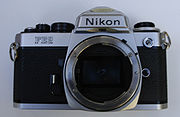
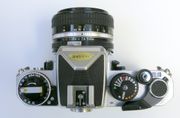
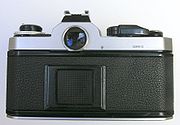
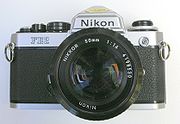
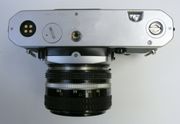
135 film
The term 135 was introduced by Kodak in 1934 as a designation for cartridge film wide, specifically for still photography. It quickly grew in popularity, surpassing 120 film by the late 1960s to become the most popular photographic film format...
, single lens reflex (SLR) camera
Camera
A camera is a device that records and stores images. These images may be still photographs or moving images such as videos or movies. The term camera comes from the camera obscura , an early mechanism for projecting images...
. It was manufactured by Nippon Kogaku K. K. (Nikon Corporation since 1988) in Japan
Japan
Japan is an island nation in East Asia. Located in the Pacific Ocean, it lies to the east of the Sea of Japan, China, North Korea, South Korea and Russia, stretching from the Sea of Okhotsk in the north to the East China Sea and Taiwan in the south...
from 1983 to 1987 (available new from dealer stock until circa 1989). The FE2 used a Nikon-designed vertical travel focal plane shutter with a speed range of 8 to 1/4000th second, plus Bulb and flash X-sync of 1/250th second. It has dimensions of 90 millimetres (3.5 in) height, 142.5 mm (5.6 in) width, 57.5 mm (2.3 in) depth and 550 grams (19.4 oz) weight, and was available in two colors: black with chrome trim and all black. The introductory US list price for the chrome body only (no lens) was $446. Note that SLRs usually sold for 30 to 40 percent below list price.
The FE2 is a member of the classic Nikon compact F-series 35 mm SLRs and was built upon a compact but rugged copper aluminum alloy chassis similar (but not identical) to the ones used by the earlier Nikon FM
Nikon FM
The Nikon FM is an advanced mechanically-operated, interchangeable lens, 35 mm film, single-lens reflex camera. It was manufactured in Japan between 1977 and 1982 by Nippon Kogaku K. K. .-History:...
(introduced in 1977), FE
Nikon FE
The Nikon FE is an advanced semi-professional level, interchangeable lens, 35 mm film, single-lens reflex camera. It was manufactured by Nikon in Japan from 1978 to 1983, and was available new from dealer stock until circa 1984...
(1978), and FM2
Nikon FM2
The Nikon FM2 is an advanced semi-professional, interchangeable lens, 35 mm film, single-lens reflex camera. It was manufactured by Nippon Kogaku K. K. in Japan from 1982 to 2001...
(1982) cameras. The FM2/FE2 twins were improved successors to the successful Nikon FM/FE cameras with enhanced features, but minor external controls and cosmetic differences. The Nikon FA
Nikon FA
The Nikon FA was an advanced amateur level, interchangeable lens, 35 mm film, single-lens reflex camera. It was manufactured by the Japanese optics company Nippon Kogaku K. K. in Japan from 1983 to 1987...
of 1983 also used this basic body design and the limited production Nikon FM3A
Nikon FM3A
The Nikon FM3A is an interchangeable lens, focal plane shutter, 35 mm film, single-lens reflex camera. It was manufactured by Nikon Corporation in Japan, on small-volume assembly lines, from 2001 to 2006. The camera was available in two colours: all black, and satin chrome...
of 2001 continued to use it until 2006.
One of the most memorable image from the Tiananmen Square protests
Tiananmen Square protests of 1989
The Tiananmen Square protests of 1989, also known as the June Fourth Incident in Chinese , were a series of demonstrations in and near Tiananmen Square in Beijing in the People's Republic of China beginning on 15 April 1989...
of China in 1989, "Tank Man", by Jeff Widener
Jeff Widener
Jeff Widener is an American photographer, best known for his image of the Tank Man confronting a column of tanks in Tiananmen Square during the 1989 Beijing riots which made him a nominated finalist for the 1990 Pulitzer...
, was shot with a Nikon FE2.
Features
The FE2 accepts all lenses with the Nikon F bayonet mountNikon F-mount
The Nikon F-mount is a type of interchangeable lens mount developed by Nikon for its 35 mm SLR cameras. The F-mount was first introduced on the Nikon F camera in 1959, and features a three lug bayonet mount with a 44 mm throat and a flange to focal plane distance of 46.5 mm...
(introduced in 1959) supporting the Automatic Indexing (AI) feature (introduced in 1977). The contemporary Nikon made AI lenses were the Nikkor AI-S, Nikkor AI and Nikon Series E types. During the early 1980s, Nippon Kogaku manufactured approximately 70 Nikkor AI-S and Nikon Series E branded lenses. They ranged from a Fisheye-Nikkor 6 mm f/2.8 220˚ circular fisheye to a Reflex-Nikkor 2000 mm f/11 super telephoto. The AF-S Nikkor, AF-I Nikkor, AF Nikkor D and AF Nikkor autofocus lenses are also AI types.
Nikon’s most recent 35 mm film SLR lenses, the AF Nikkor G type (introduced in 2000) lacking an aperture control ring; and the AF Nikkor DX type (2003) with image circles sized for Nikon's digital SLRs will mount, but will not function properly. IX Nikkor lenses (1996), for Nikon's Advanced Photo System
Advanced Photo System
Advanced Photo System is a film format for still photography first produced in 1996. It was marketed by Eastman Kodak under the brand name Advantix, by FujiFilm under the name Nexia, by AgfaPhoto under the name Futura and by Konica as Centuria.- Design :The film is 24 mm wide, and has three...
(APS) film SLRs, must not be mounted, as their rear elements will intrude far enough into the mirror box to cause damage.
Accessories for the FE2 included the Nikon MD-12 motor drive
Motor drive
A motor drive, in the field of photography, is a powered film transport mechanism. Historically, film loading, advancing, and rewinding were all manually driven functions...
(automatic film advance up to 3.2 frames per second), the Nikon MF-16 databack (sequential numbering, time or date stamping on the film), and the Nikon SB-15 (guide number 82/25 (feet/meters) at ASA/ISO 100) and Nikon SB-16B (guide number 105/32 (feet/meters) at ASA/ISO 100) electronic flashes.
The FE2 is a battery powered (two S76 or A76, or one 1/3N) electromechanically controlled manual focus SLR with manual exposure control or aperture priority autoexposure. It has a match-needle exposure control system using two needles pointing along a vertical shutter speed scale on the left side of the viewfinder to indicate the readings of the built-in 60/40 percent centerweighted light meter versus the actual camera settings. This system can be traced back to the Nikkormat EL (in the USA/Canada; Nikomat EL, rest of the world) of 1972 and continued until 2006 with the Nikon FM3A. The viewfinder also has an interchangeable Type K2 focusing screen with Nikon's standard 3 mm split image rangefinder and 1 mm microprism collar focusing aids plus 12 mm etched circle indicating the area of the meter centerweighting.
The major improvements in the FE2 compared to the FE are silicon photodiode
Photodiode
A photodiode is a type of photodetector capable of converting light into either current or voltage, depending upon the mode of operation.The common, traditional solar cell used to generateelectric solar power is a large area photodiode....
light meter
Light meter
A light meter is a device used to measure the amount of light. In photography, a light meter is often used to determine the proper exposure for a photograph...
sensors, internal printed circuit electronics, provision for through-the-lens
Through-the-lens
Through-the-lens metering is a photographic term describing a feature of cameras capable of measuring light levels in a scene through their taking lenses, as opposed to a separate metering window...
(TTL) off-the-film (OTF) electronic flash automation (essentially identical to the system introduced in the Nikon FG
Nikon FG
The Nikon FG is an interchangeable lens, 35 mm film, single-lens reflex camera. It was manufactured by Nippon Kogaku K. K. in Japan from 1982 to 1986....
in 1982) and a quartz oscillator timed, bearing-mounted, titanium-bladed shutter reaching an ultra-fast top speed of 1/4000th second (plus world's fastest X-sync to 1/250th second). This design is an improved electronically controlled version of the mechanical shutter introduced in the Nikon FM2, with eight honeycomb-patterned blades instead of nine and shutter curtain travel time further reduced to 3.3 milliseconds from 3.6 milliseconds. The FE2 also introduced a unique rotating flywheel plus inertial mass damping system to minimize mirror shock vibration effects and obviate the need for a mirror lockup feature.
Design History
The 1970s and 1980s were an era of intense competition between the major SLR brands: Nikon, CanonCanon Inc.
is a Japanese multinational corporation that specialises in the manufacture of imaging and optical products, including cameras, camcorders, photocopiers, steppers and computer printers. Its headquarters are located in Ōta, Tokyo, Japan.-Origins:...
, Minolta
Minolta
Minolta Co., Ltd. was a Japanese worldwide manufacturer of cameras, camera accessories, photocopiers, fax machines, and laser printers. Minolta was founded in Osaka, Japan, in 1928 as . It is perhaps best known for making the first integrated autofocus 35mm SLR camera system...
, Pentax
Pentax
Pentax is a brand name used by Hoya Corporation for its medical-related products & services and Pentax Ricoh Imaging Company for cameras, sport optics , etc. Hoya purchased and merged with the Japanese optics company on March 31, 2008. Hoya's Pentax imaging business was sold to Ricoh Company, Ltd...
and Olympus. Between circa 1975 to 1985, there was a dramatic shift away from heavy all-metal manual mechanical camera bodies to much more compact bodies with integrated circuit (IC) electronic automation. In addition, because of rapid advances in electronics, the brands continually leap frogged each other with models having new or more automatic features. The industry was trying to expand out from the saturated high-end professional market and appeal to the large mass of low-end amateur photographers itching to move up from compact automatic leaf-shutter rangefinder (RF) cameras to the more versatile SLR but were intimidated by the need to learn all details of its operation.
The FE2 was intended by Nikon as a quality alternative to the more cheaply built 35 mm amateur SLRs by other manufacturers of the day. It can be described as Nippon Kogaku’s Nikon FM2 mechanical (springs, gears, levers) camera with precision electronic controls grafted on. Its unusual roots were most obvious in its backup ability to operate without batteries – albeit in a limited fashion: completely manual mechanical control with limited shutter speeds (1/250th second, marked M250, or Bulb) and without the light meter. The FE2 shared the luxurious bearing-mounted film advance and transport mechanism of its other high-level cameras, and many were used by professional photographers. The FE2’s deliberately conservative external features (no program modes or matrix metering) were not intended to appeal to beginners, but rather to experienced photographers who required a reliable camera capable of withstanding extremes of climate, impacts, and extended use. Nikon believed that advanced amateur photographers were not interested in every possible automated bell and whistle, but rather the highest possible quality and precision.
Although the FE2 sold well, it was not as popular as less expensive competing contemporary SLRs with a fancier feature set but vastly inferior internal design and construction quality – for example, the Canon A-1
Canon A-1
The Canon A-1 is an advanced level single-lens reflex 35 mm film camera for use with interchangeable lenses. It was manufactured by Canon Camera K. K. in Japan from April 1978 to 1985. It employs a horizontal cloth-curtain focal-plane shutter with a speed range of 30 to 1/1000 second plus bulb...
(1978) or the Minolta X-700
Minolta X-700
The Minolta X-700 is a 35 mm single-lens reflex camera introduced by Minolta in 1981. It was the top model of their final manual-focus SLR series before the introduction of the auto-focus Minolta Maxxum 7000...
(1982). Time has proven Nikon's philosophy to be the right one – it is very tough and reliable and it is now regarded as one of the finest SLRs of its generation. It is very popular on the user-collectible market and commands prices (in excellent condition) higher than when it was new.
External links
- Nikon FE2 photo from Nikon Corp (Japan) online archives
- Nikon FE2
- Nikon FE2 information page from Nikon Corp online archives
- Nikon FE2 articles from www.mir.com.my Photography in Malaysia

